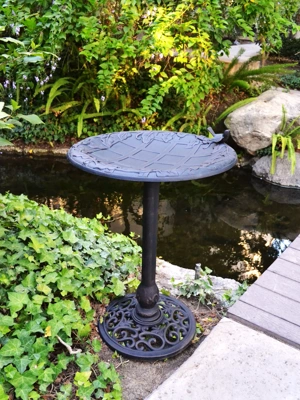Supporting Wildlife in Your Own Backyard
A Yard That Welcomes Winged and Warty Friends

Even when the birdfeeders are put away for the summer, the garden can still be a welcoming place for birds.
Early morning is my favorite time to be in the garden. During May and June I'm up and out by five, eager to steal an hour before it's time for work and family responsibilities. In the soft light of morning, my garden belongs more to the natural world than it does to me. I might weed a few things, move a plant or two, and cut some flowers, but mostly I just soak it all in; looking and listening for the creatures that bring my garden to life.
Birds
Birds provide the musical score to my morning wanderings. Though the feeders have been put away for the summer, my garden has lots of other bird-friendly attractions. The robins feast on earthworms, the sparrows snack on bugs, the grosbeaks cruise the shrubs to make sure they get first dibs on any ripening berries. Fruit-bearing shrubs and small trees provide welcome cover and nesting spots for all kinds of birds. If you're going to be planting new landscape plants, consider selecting plants that produce a crop of berries or seeds for your bird friends. Some of my favorites include viburnums, serviceberry, and honeysuckle. Two books I recommend on this subject are Planting Noah's Garden: Further Adventures in Backyard Ecology by Sara Stein (Houghton Mifflin, 1997) and The National Wildlife Federation's Guide to Gardening for Wildlife by Craig Tufts and Peter Loewer (Rodale, 1995).
More information: Attracting Birds
Hummingbirds
Once or twice during my morning wanderings, I usually hear the thrumming of the hummingbird's wings as it cruises through to see what flowers are opening that day. I have a fuchsia hanging under a tree — often the first stop — then it's on to the bee balm and anything else that is red, including my hummingbird feeder.
More information: Attracting Butterflies, Hummingbirds and Other Pollinators.
Toads and Reptiles
Toads are another of my favorite garden creatures, though they're about as different from a hummingbird as you can get. There's usually a grand-daddy toad living under the rhubarb in the vegetable garden. I don't know when he comes out to eat, but I'm happy to give him credit for keeping my garden free of most troublesome insect pests. Toads don't require much; just a shady, moist, out-of-the-way spot.
My rock garden is where the reptiles hang out. A beautiful green garter snake lives between some of the rocks. Morning is when it suns itself, warming up before heading off to work in the garden. I like snakes as long as they don't take me by surprise. I'm not sure why, but I consider them a sign that the garden is creature-friendly and in balance.
Just Add Water
If you want to lure wildlife to your garden, adding water will really make a splash. Besides attracting birds of all kinds, you'll provide important new habitat for all sorts of wildlife: frogs and dragonflies, water striders, salamanders and guppies—just to name a few. I'm fortunate to have two natural water features near my gardens: a pond and a small stream. Both of them usually dry up by midsummer, but in the spring and fall they're teeming with life. Nowadays, you don't have to rely on Mother Nature to provide water features. You can even put a fair-sized water garden right on your deck, using a sturdy, watertight tub.
Don't Forget Bats
Although bats are burdened with the "vampire" reputation, about 70 percent of bat species consume insects. According to the Defenders of Wildlife, a single brown bat can eat up to 1,000 mosquitoes in an hour. They also help pollinate many types of vegetation. In North America, bats find shelter in caves, crevices, tree cavities and buildings. They will also use specially designed bat shelters.
More information: All About Bats.
Butterflies
These "flying flowers" will float in and out of your garden all day long if you offer a few of their favorite foods. In my garden, their favorites include coneflowers (echinacea), cosmos, asters, black-eyed Susans (rudbeckia) and other daisy-like flowers, zinnias, lilacs, bishop's flower (Ammi majus) and dill. Near the end of my driveway there's a 15-by-15-foot patch of milkweed. Milkweed is the monarch caterpillar's preferred food and I figure I'm responsible for keeping at least a dozen or more of them well fed.
More information: Attracting Butterflies, Hummingbirds and Other Pollinators.
Bees
Last, but probably most important as far as gardeners are concerned, are the bees. As an organic gardener, I don't need to worry about poisoning bees. They love my garden. The flower beds are filled with bees from dawn to dusk (annual poppies get my vote for attracting the most) and the bees thank me by doing a thorough job of pollinating everything in the vegetable garden as well. In some parts of the country, bee populations are alarmingly low. All the more reason to garden organically. You can have a powerful and rewarding impact in your own backyard by providing a safe haven for as many of earth's creatures as you can.
More information: Attracting Bees.
Last updated: 03/13/2024
Print this Article:
Related items
Get the Dirt
Stay up to date on new articles and advice. Please fill out the information below.










